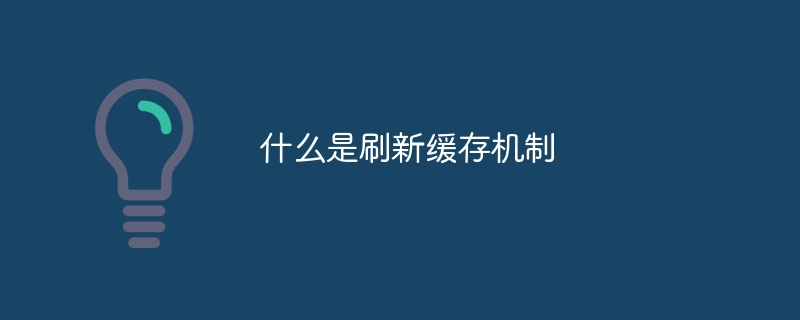
The refresh cache mechanism refers to a mechanism that updates cached data periodically or according to specific conditions to ensure that the data in the cache is up to date. Refresh cache mechanisms usually include scheduled refresh, event triggering, manual refresh, invalidation mechanism, etc. In many computing and data processing scenarios, due to performance and efficiency considerations, caching mechanisms are often used to store frequently accessed data to reduce the number of accesses to the original data source. Refreshing the cache mechanism is one of the keys to ensuring the accuracy and timeliness of cached data. It is necessary to select the appropriate refresh method according to the actual scenario and design and implement it accordingly.

The operating system for this tutorial: Windows 10 system, DELL G3 computer.
The refresh cache mechanism refers to a mechanism that updates cached data periodically or according to specific conditions to ensure that the data in the cache is up to date.
In many computing and data processing scenarios, due to performance and efficiency considerations, caching mechanisms are usually used to store frequently accessed data to reduce the number of accesses to the original data source. However, because data may change frequently, in some cases the data in the cache may become outdated or no longer accurate. To solve this problem, a refresh cache mechanism needs to be used to update the data in the cache periodically or based on specific conditions.
The refresh cache mechanism usually includes the following methods:
1. Scheduled refresh: regularly update the data in the cache. The refresh interval is usually determined based on the update frequency and importance of the data.
2. Event triggering: When the original data changes, the cache update is triggered through event notification. This method is suitable for scenarios where data updates are frequent and data consistency requirements are high.
3. Manual refresh: Provide an interface or button to manually refresh the cache. When the user finds that the data is inaccurate or expired, the cache update can be manually triggered.
4. Invalidation mechanism: Set an expiration time or expiration flag in the cache. When the cache reaches the expiration time or the expiration flag is detected, the cache update is automatically triggered.
When implementing the refresh cache mechanism, the following points need to be considered:
1. Data consistency: When updating the cache, ensure that the updated data is consistent with the original data source to avoid Data inconsistency occurs.
2. Performance impact: Updating the cache may have a certain impact on system performance, especially in high concurrency or big data processing scenarios. Therefore, it is necessary to minimize the impact on system performance while ensuring data consistency.
3. Cache expiration time: The cache expiration time needs to be determined based on the update frequency and importance of the data. If the data is updated frequently, the expiration time needs to be shortened to ensure the accuracy of the data; if the data is of low importance and the update frequency is low, the expiration time can be appropriately extended to reduce the frequency of update operations.
4. Data source changes: If the data structure or data type of the original data source changes, the cache needs to be updated accordingly to adapt to the new data structure or type.
5. Concurrency control: In a multi-thread or multi-process environment, concurrency control measures need to be taken to ensure the atomicity and consistency of cache updates.
6. Monitoring and statistics: The cache refresh operation needs to be monitored and counted so that problems can be discovered and optimized in a timely manner. For example, statistics on cache hit rate, refresh frequency, data volume and other indicators can be used to evaluate the effect of the cache and make corresponding adjustments.
In summary, refreshing the cache mechanism is one of the keys to ensuring the accuracy and timeliness of cached data. It is necessary to select the appropriate refresh method and design and implement it accordingly according to the actual scenario.
The above is the detailed content of What is the refresh cache mechanism?. For more information, please follow other related articles on the PHP Chinese website!
 What caching mechanisms does php have?
What caching mechanisms does php have?
 How to copy an Excel table to make it the same size as the original
How to copy an Excel table to make it the same size as the original
 What are the short video platforms?
What are the short video platforms?
 What is a browser plug-in
What is a browser plug-in
 What should I do if my QQ account is stolen?
What should I do if my QQ account is stolen?
 The difference between export and export default
The difference between export and export default
 Where is the audio interface located on the motherboard?
Where is the audio interface located on the motherboard?
 Introduction to strings
Introduction to strings




